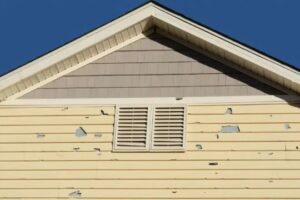Siding is one of the most critical elements of a home’s exterior. It protects the structure from harsh weather, enhances curb appeal, and contributes to insulation. Over time, however, siding can suffer from damage due to moisture, pests, or general wear and tear. When issues arise, homeowners must decide whether to handle the repairs themselves or call a professional. Understanding the scope of the damage and the complexity of the repair can help make the right choice.
Identifying Common Siding Issues
 Siding can deteriorate for various reasons, and recognizing the early signs of damage is essential. Cracks, warping, and loose panels are often the first indications that a repair is necessary. Moisture intrusion is another major concern, as it can lead to mold growth and rotting wood beneath the surface. Fading or discoloration might seem like a cosmetic issue, but it could indicate prolonged exposure to the elements, weakening the siding material over time. In some cases, pests such as termites and carpenter ants can cause structural damage that needs immediate attention.
Siding can deteriorate for various reasons, and recognizing the early signs of damage is essential. Cracks, warping, and loose panels are often the first indications that a repair is necessary. Moisture intrusion is another major concern, as it can lead to mold growth and rotting wood beneath the surface. Fading or discoloration might seem like a cosmetic issue, but it could indicate prolonged exposure to the elements, weakening the siding material over time. In some cases, pests such as termites and carpenter ants can cause structural damage that needs immediate attention.
When to Attempt DIY Siding Repair
Homeowners with basic handyman skills can handle minor siding issues without hiring a contractor. Small cracks or holes in vinyl siding, for example, can often be patched with caulk or a siding repair kit. Reattaching a loose panel is another simple fix that requires minimal tools. If the damage is isolated to a single section, replacing a single board or panel might be feasible with the right materials and a bit of patience.
Wood siding may also allow for simple DIY fixes, such as sanding down minor rot and applying wood filler before repainting the area. However, working with wood requires careful attention to detail to prevent moisture issues in the future. If the siding is relatively new and matches the available replacement material, the repair process can be straightforward.
The Risks of DIY Repairs
 While tackling siding repairs on your own can save money, there are risks involved. Without proper installation techniques, even a small mistake can lead to bigger problems down the road. Water damage is a major concern, as improper sealing can allow moisture to seep behind the siding and compromise the home’s structure. Using the wrong materials or mismatched colors can also impact the home’s appearance.
While tackling siding repairs on your own can save money, there are risks involved. Without proper installation techniques, even a small mistake can lead to bigger problems down the road. Water damage is a major concern, as improper sealing can allow moisture to seep behind the siding and compromise the home’s structure. Using the wrong materials or mismatched colors can also impact the home’s appearance.
For those unfamiliar with power tools or construction techniques, there is also a safety factor to consider. Working at heights on a ladder can be dangerous, and certain siding materials, such as fiber cement, require specialized tools that homeowners may not have on hand.
When to Call a Professional
Some siding issues go beyond the capabilities of a DIY fix and require professional expertise. If the damage extends across multiple sections or involves structural concerns, hiring a contractor is the best option. Large cracks or holes, especially those affecting insulation and waterproofing, should be handled by an expert to prevent long-term issues.
Water infiltration behind the siding is another situation where professional assistance is necessary. If moisture has caused mold growth or rot in the underlying structure, a siding contractor will have the experience to properly address the damage and prevent further deterioration. In cases where pests have compromised the siding, a professional can determine the extent of the problem and recommend the best course of action.
Certain types of siding, such as stucco, fiber cement, or brick veneer, require specialized knowledge and tools for repair. Incorrectly handling these materials can lead to costly mistakes, so leaving the job to an experienced contractor ensures a proper fix.
Cost Considerations for Siding Repair
The cost of siding repair varies depending on the material, extent of damage, and labor required. DIY repairs are generally more affordable, as they primarily involve purchasing materials and tools. However, if mistakes are made, the cost of fixing errors can add up. Professional repairs come with labor costs, but they also provide peace of mind and often include warranties.
For minor damage, a small repair job may cost only a few hundred dollars, while extensive repairs or full siding replacement can run into the thousands. Consulting with a contractor for an estimate can help homeowners decide whether a DIY fix is worth the risk or if hiring a professional is the better investment.
Choosing the Right Siding Contractor
When hiring a professional, selecting the right contractor is crucial. Homeowners should research local siding specialists, read customer reviews, and request quotes from multiple providers. Checking for licensing, insurance, and warranties can help ensure a reputable contractor is chosen for the job. Clear communication about the scope of work, timeline, and costs should be established before the project begins.